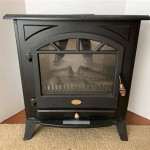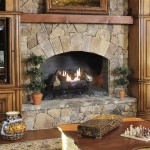Ideas for a Brick Fireplace Makeover
A brick fireplace, often the focal point of a living room or family room, can become dated or simply not align with current aesthetic preferences. Instead of demolishing and rebuilding, a fireplace makeover offers a cost-effective and less disruptive solution. This article explores various ideas for transforming a brick fireplace, covering a range of styles and budgets to inspire a refreshed and revitalized hearth.
Paint Transformations: A Spectrum of Possibilities
Painting the brick is arguably the most impactful and budget-friendly way to alter the appearance of a fireplace. The choice of paint color and technique determines the final look, ranging from a subtle refresh to a dramatic statement.
Whitewashing: This technique involves diluting white paint with water and applying it to the brick. The diluted paint allows the brick's texture to remain visible, creating a soft, aged appearance. The amount of water used in the paint mixture dictates the opacity of the whitewash, allowing for customization of the final result. Whitewashing complements farmhouse, rustic, and coastal interior styles. Preparation involves thoroughly cleaning the brick and applying a masonry primer before the whitewash application.
Limewashing: Similar to whitewashing, limewashing utilizes a lime-based paint, historically employed for its antimicrobial and breathable properties. This technique provides a chalky, matte finish with subtle color variations due to the lime's natural composition. Limewash offers a more organic and textured look compared to regular paint. The application process is similar to whitewashing, requiring clean brick and potentially a primer for optimal adhesion. Limewashing often exudes a vintage or European aesthetic.
Solid Color Painting: For a more modern and uniform aesthetic, painting the brick in a solid color offers a clean and contemporary look. Choosing a color that complements the room's existing palette is crucial. Neutral colors like gray, beige, or off-white provide a versatile backdrop, while bolder colors like charcoal or navy can create a dramatic focal point. Specialized masonry paint is recommended to ensure proper adhesion and breathability. The brick should be thoroughly cleaned and primed with a masonry primer to promote paint adherence and prevent moisture damage. Multiple coats of paint are typically required for complete coverage and a uniform finish.
Distressed Painting: This technique involves painting the brick a solid color and then intentionally removing some of the paint to reveal the brick underneath. This creates a weathered and aged appearance, adding character and visual interest. Sandpaper, a wire brush, or a paint scraper can be utilized to distress the paint. The level of distressing can be customized to achieve the desired effect, from subtle wear to a more pronounced rustic look. This technique complements farmhouse, industrial, and vintage interior styles.
Adding Architectural Elements: Enhancing the Fireplace's Structure
Beyond paint, incorporating architectural elements can significantly alter the fireplace's style and visual appeal. Mantels, surrounds, and other additions offer opportunities to customize the fireplace to match the room's design.
Installing a New Mantel: Replacing an existing mantel or adding a new one is a relatively straightforward way to update the fireplace's look. Mantels are available in various materials, including wood, stone, and metal, and in a wide range of styles, from traditional to modern. A substantial wooden mantel can add warmth and rustic charm, while a sleek metal mantel can create a contemporary feel. The mantel's size and style should be proportionate to the fireplace and the room. Installation typically involves securing the mantel to the brick using appropriate fasteners. Considerations must be given to the fireplace's clearances and safety codes concerning combustible materials.
Adding a Fireplace Surround: A fireplace surround frames the firebox and provides an opportunity to introduce different materials and textures. Surrounds can be crafted from stone, tile, wood, or a combination of materials. A stone surround can create a natural and elegant look, while a tile surround offers a wide range of colors and patterns. Wood surrounds can be custom-built to match the room's existing trim work. Installing a surround typically involves adhering the materials to the brick using mortar or adhesive. Careful measurements and precise cuts are essential for a clean and professional finish. The design should complement the overall aesthetic of the room.
Creating a Built-In Bookcase or Shelving: Extending the fireplace into surrounding built-in bookcases or shelving units can transform the entire wall into a focal point. This option not only enhances the fireplace's aesthetic but also provides functional storage and display space. The shelves can be custom-built to accommodate books, artwork, and other decorative items. The design should integrate seamlessly with the fireplace surround and mantel, creating a cohesive and balanced look. This project typically requires professional carpentry skills and careful planning to ensure proper structural support and aesthetic harmony.
Adding a Raised Hearth: A raised hearth can elevate the fireplace both visually and physically. It creates a more prominent focal point and can also provide additional seating. The hearth can be constructed from brick, stone, or concrete, and its size and shape can be customized to fit the room. A raised hearth can also serve as a safety feature, providing a buffer between the firebox and the surrounding floor. The installation requires careful planning and construction to ensure proper support and stability. Consider the room's traffic flow and ensure the raised hearth does not create a tripping hazard.
Surface Treatments: Texture and Dimension
Beyond painting and adding architectural elements, various surface treatments can add texture and dimension to the brick, creating a unique and visually appealing fireplace.
Applying a Brick Stain: Unlike paint, brick stain penetrates the brick's surface, altering its color without completely obscuring its natural texture. Staining offers a more subtle color change and allows the brick's character to remain visible. Brick stain comes in a variety of colors, from natural earth tones to bolder hues. The application process involves cleaning the brick and applying the stain with a brush or sprayer. Multiple coats may be required to achieve the desired color intensity. Brick stain is a durable and long-lasting option that resists fading and peeling.
Adding a Faux Stone or Brick Veneer: For a completely different look, applying a faux stone or brick veneer over the existing brick offers a transformative solution. Veneer products are designed to replicate the look and feel of natural stone or brick at a fraction of the cost. They are available in a wide range of styles, colors, and textures. The installation process involves adhering the veneer panels to the brick using mortar or adhesive. The veneer panels are typically lightweight and easy to cut, making the installation process relatively straightforward. Faux stone or brick veneer can create a rustic, modern, or traditional look, depending on the chosen style.
Applying a Concrete Overlay: A concrete overlay can create a smooth and modern surface over the existing brick. The concrete can be tinted to achieve the desired color. The application process involves preparing the brick surface and applying a thin layer of concrete overlay. The overlay can be textured or left smooth, depending on the desired look. A concrete overlay creates a sleek and contemporary fireplace that complements minimalist and industrial interior styles.
Grouting or Re-Grouting the Brick: The grout lines between the bricks can significantly impact the fireplace's overall appearance. Cleaning and refreshing the grout can brighten the fireplace and restore its original look. Re-grouting with a different color grout can also dramatically alter the fireplace's style. For example, dark grout can create a more modern and graphic look, while light grout can create a softer and more traditional look. The re-grouting process involves removing the old grout and applying new grout with a grout float. Proper sealing is essential to protect the grout from staining and moisture damage.
These ideas provide a foundation for planning a brick fireplace makeover. The key lies in aligning the chosen techniques with the overall aesthetic goals for the room and carefully considering the budget and skill level required for each project.

40 Brick Fireplace Ideas Captivating Showstoppers With Timeless Charm Makeover White

Brick Fireplace Makeover Before And After Decorating Painting Id Painted Fireplaces Paint

16 Red Brick Fireplace Makeover Ideas

Brick Fireplace Makeover Before And After Ideas Cool Makeovers Remodel Home Red Fireplaces

Diy Painted Brick Fireplace Makeover On A Budget Before After The Confused Millennial

16 Red Brick Fireplace Makeover Ideas

10 Fireplace Makeover Ideas Before And After Regency

11 Brick Fireplace Makeovers My Blessed Life

25 Beautiful Diy Brick Fireplace Makeovers

10 Painted Brick Fireplace Makeovers You Can Do On A Budget Run To Radiance
Related Posts








